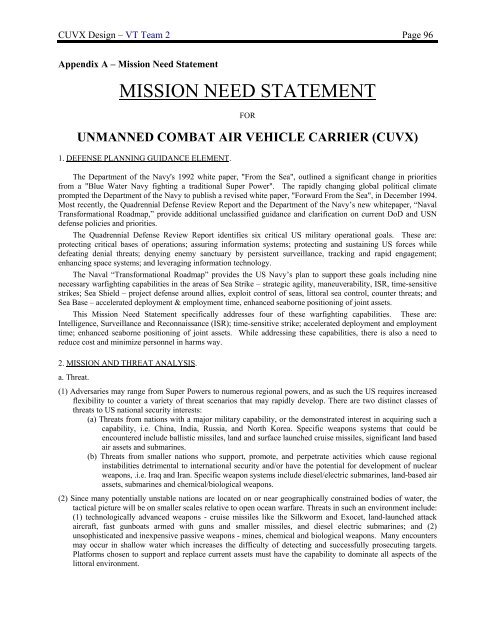CUVX Design Report - the AOE home page - Virginia Tech
CUVX Design Report - the AOE home page - Virginia Tech
CUVX Design Report - the AOE home page - Virginia Tech
Create successful ePaper yourself
Turn your PDF publications into a flip-book with our unique Google optimized e-Paper software.
<strong>CUVX</strong> <strong>Design</strong> – VT Team 2 Page 96Appendix A – Mission Need StatementMISSION NEED STATEMENTFORUNMANNED COMBAT AIR VEHICLE CARRIER (<strong>CUVX</strong>)1. DEFENSE PLANNING GUIDANCE ELEMENT.The Department of <strong>the</strong> Navy's 1992 white paper, "From <strong>the</strong> Sea", outlined a significant change in prioritiesfrom a "Blue Water Navy fighting a traditional Super Power". The rapidly changing global political climateprompted <strong>the</strong> Department of <strong>the</strong> Navy to publish a revised white paper, "Forward From <strong>the</strong> Sea", in December 1994.Most recently, <strong>the</strong> Quadrennial Defense Review <strong>Report</strong> and <strong>the</strong> Department of <strong>the</strong> Navy’s new whitepaper, “NavalTransformational Roadmap,” provide additional unclassified guidance and clarification on current DoD and USNdefense policies and priorities.The Quadrennial Defense Review <strong>Report</strong> identifies six critical US military operational goals. These are:protecting critical bases of operations; assuring information systems; protecting and sustaining US forces whiledefeating denial threats; denying enemy sanctuary by persistent surveillance, tracking and rapid engagement;enhancing space systems; and leveraging information technology.The Naval “Transformational Roadmap” provides <strong>the</strong> US Navy’s plan to support <strong>the</strong>se goals including ninenecessary warfighting capabilities in <strong>the</strong> areas of Sea Strike – strategic agility, maneuverability, ISR, time-sensitivestrikes; Sea Shield – project defense around allies, exploit control of seas, littoral sea control, counter threats; andSea Base – accelerated deployment & employment time, enhanced seaborne positioning of joint assets.This Mission Need Statement specifically addresses four of <strong>the</strong>se warfighting capabilities. These are:Intelligence, Surveillance and Reconnaissance (ISR); time-sensitive strike; accelerated deployment and employmenttime; enhanced seaborne positioning of joint assets. While addressing <strong>the</strong>se capabilities, <strong>the</strong>re is also a need toreduce cost and minimize personnel in harms way.2. MISSION AND THREAT ANALYSIS.a. Threat.(1) Adversaries may range from Super Powers to numerous regional powers, and as such <strong>the</strong> US requires increasedflexibility to counter a variety of threat scenarios that may rapidly develop. There are two distinct classes ofthreats to US national security interests:(a) Threats from nations with a major military capability, or <strong>the</strong> demonstrated interest in acquiring such acapability, i.e. China, India, Russia, and North Korea. Specific weapons systems that could beencountered include ballistic missiles, land and surface launched cruise missiles, significant land basedair assets and submarines.(b) Threats from smaller nations who support, promote, and perpetrate activities which cause regionalinstabilities detrimental to international security and/or have <strong>the</strong> potential for development of nuclearweapons, .i.e. Iraq and Iran. Specific weapon systems include diesel/electric submarines, land-based airassets, submarines and chemical/biological weapons.(2) Since many potentially unstable nations are located on or near geographically constrained bodies of water, <strong>the</strong>tactical picture will be on smaller scales relative to open ocean warfare. Threats in such an environment include:(1) technologically advanced weapons - cruise missiles like <strong>the</strong> Silkworm and Exocet, land-launched attackaircraft, fast gunboats armed with guns and smaller missiles, and diesel electric submarines; and (2)unsophisticated and inexpensive passive weapons - mines, chemical and biological weapons. Many encountersmay occur in shallow water which increases <strong>the</strong> difficulty of detecting and successfully prosecuting targets.Platforms chosen to support and replace current assets must have <strong>the</strong> capability to dominate all aspects of <strong>the</strong>littoral environment.
















